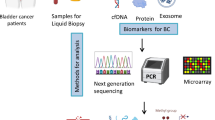Abstract
Background
Solute carrier (SLC) 22 A1, A2, and A3 are polyspecific transporters transporting organic cations like histamine, serotonin, norepinephrine, dopamine, MPP + , and toxins. The expression of SLC22A1–A3 in cancer is seldom investigated, and the function of SLC22A1–A3 in glioblastoma multiforme (GBM) is never elucidated.
Materials
In our study, we detected the expression of SLC22A1–A3 in 11 fresh GBMs and tumor-adjacent brain tissues with qPCR, and in 129 paraffin-embedded GBMs with immunohistochemistry (IHC). With chi-square test, we investigated the correlation between expression of SLC22A1–A3 and the clinicopathological factors including patients’ age, sex, tumor size, and KPS score. With Kaplan–Meier method and Cox-regression model, we estimated the prognostic significance of SLC22A1–A3 in GBM.
Results
SLC22A3 was significantly downregulated in GBMs compared with the tumor-adjacent normal tissues. With univariate survival analyses, we showed that SLC22A3, instead of SLC22A1 and A2, was an independent biomarker predicting favorable prognosis. With multivariate analyses, SLC22A3 was identified as an independent prognostic biomarker indicating the favorable outcome of GBM.
Conclusions
SLC22A3 is an independent favorable prognostic biomarker of GBM. Patients with low SLC22A3 may be more high-risk and should receive more intensive post-operational supervision and treatments.


Similar content being viewed by others

References
Wen PY, Kesari S (2008) Malignant gliomas in adults. N Engl J Med 359:492–507
Ostrom QT, Gittleman H, Fulop J et al (2015) CBTRUS statistical report: primary brain and central nervous system tumors diagnosed in the United States in 2008–2012. Neuro-oncology 17 Suppl 4: iv1-iv62
Dong C, Fan W, Fang S (2020) PBK as a potential biomarker associated with prognosis of glioblastoma. J Mol Neurosci : MN 70:56–64
Lee EQ, Muzikansky A, Drappatz J et al (2016) A randomized, placebo-controlled pilot trial of armodafinil for fatigue in patients with gliomas undergoing radiotherapy. Neuro Oncol 18:849–854
Stupp R, Hegi ME, Mason WP et al (2009) Effects of radiotherapy with concomitant and adjuvant temozolomide versus radiotherapy alone on survival in glioblastoma in a randomised phase III study: 5-year analysis of the EORTC-NCIC trial. Lancet Oncol 10:459–466
Verhaak RG, Hoadley KA, Purdom E et al (2010) Integrated genomic analysis identifies clinically relevant subtypes of glioblastoma characterized by abnormalities in PDGFRA, IDH1, EGFR, and NF1. Cancer Cell 17:98–110
Roth M, Obaidat A, Hagenbuch B (2012) OATPs, OATs and OCTs: the organic anion and cation transporters of the SLCO and SLC22A gene superfamilies. Br J Pharmacol 165:1260–1287
Koepsell H, Endou H (2004) The SLC22 drug transporter family. Pflugers Arch 447:666–676
Liu X (2019) SLC family transporters. Adv Exp Med Biol 1141:101–202
Sweet DH (2005) Organic anion transporter (Slc22a) family members as mediators of toxicity. Toxicol Appl Pharmacol 204:198–215
Hsu CM, Lin PM, Chang JG et al (2017) Upregulated SLC22A3 has a potential for improving survival of patients with head and neck squamous cell carcinoma receiving cisplatin treatment. Oncotarget 8:74348–74358
Herraez E, Lozano E, Macias RI et al (2013) Expression of SLC22A1 variants may affect the response of hepatocellular carcinoma and cholangiocarcinoma to sorafenib. Hepatology 58:1065–1073
Lautem A, Heise M, Grasel A et al (2013) Downregulation of organic cation transporter 1 (SLC22A1) is associated with tumor progression and reduced patient survival in human cholangiocellular carcinoma. Int J Oncol 42:1297–1304
Du K, Wu X, Ji X et al (2020) Early growth response 1 promoted the invasion of glioblastoma multiforme by elevating HMGB1. J Neuro Sci
Zhao B, Sun J, Du K, Liang N (2020) Sprouty 4 suppresses glioblastoma invasion by inhibiting ERK phosphorylation and ETS-1-induced matrix metalloproteinase-9. J Neuro Sci
Chen T, Li K, Liu Z et al (2021) WDR5 facilitates EMT and metastasis of CCA by increasing HIF-1alpha accumulation in Myc-dependent and independent pathways. Mol ther : the journal of the American Society of Gene Therapy
Kolz C, Schaeffeler E, Schwab M, Nies AT (2021) Genetic and epigenetic regulation of organic cation transporters. Handb Exp Pharmacol
Schaeffeler E, Hellerbrand C, Nies AT et al (2011) DNA methylation is associated with downregulation of the organic cation transporter OCT1 (SLC22A1) in human hepatocellular carcinoma. Genome medicine 3:82
Tomlins SA, Mehra R, Rhodes DR et al (2007) Integrative molecular concept modeling of prostate cancer progression. Nat Genet 39:41–51
Ren A, Sun S, Li S et al (2019) Genetic variants in SLC22A3 contribute to the susceptibility to colorectal cancer. Int J Cancer 145:154–163
Heise M, Lautem A, Knapstein J et al (2012) Downregulation of organic cation transporters OCT1 (SLC22A1) and OCT3 (SLC22A3) in human hepatocellular carcinoma and their prognostic significance. BMC Cancer 12:109
Cervenkova L, Vycital O, Bruha J et al (2019) Protein expression of ABCC2 and SLC22A3 associates with prognosis of pancreatic adenocarcinoma. Sci Rep 9:19782
Mohelnikova-Duchonova B, Brynychova V, Hlavac V et al (2013) The association between the expression of solute carrier transporters and the prognosis of pancreatic cancer. Cancer Chemother Pharmacol 72:669–682
Wu X, Huang W, Ganapathy ME et al (2000) Structure, function, and regional distribution of the organic cation transporter OCT3 in the kidney. Am J Physiol Renal Physiol 279:F449-458
Amphoux A, Vialou V, Drescher E et al (2006) Differential pharmacological in vitro properties of organic cation transporters and regional distribution in rat brain. Neuropharmacology 50: 941–952
Grundemann D, Schechinger B, Rappold GA, Schomig E (1998) Molecular identification of the corticosterone-sensitive extraneuronal catecholamine transporter. Nat Neurosci 1:349–351
Pavlidis N, Kalef-Ezra J, Briassoulis E et al (1994) Evaluation of six tumor markers in patients with carcinoma of unknown primary. Med Pediatr Oncol 22:162–167
Author information
Authors and Affiliations
Corresponding author
Ethics declarations
Conflict of interest
The authors declare no competing interests.
Rights and permissions
About this article
Cite this article
Lian, Q., Xiao, S., Wang, Y. et al. Expression and clinical significance of organic cation transporter family in glioblastoma multiforme. Ir J Med Sci 191, 1115–1121 (2022). https://doi.org/10.1007/s11845-021-02675-3
Received:
Accepted:
Published:
Issue Date:
DOI: https://doi.org/10.1007/s11845-021-02675-3



